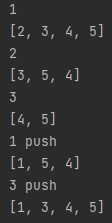힙 ?
힙(Heap)구조란 완전 이진 트리의 일종으로 어떤 데이터 중 최대값이나 최소값을 빠르게 찾아내도록 만들어진 구조이다.
부모노드의 키 값이 자식노드의 키 값보다 큰(작은) 관계가 유지되어 트리 내에서 가장 큰(작은) 키 값을 가진 노드는 항상 루트노드가 된다.
- 최소 힙 (Min Heap) : 부모노드의 키 값이 자식노드의 키 값보다 항상 작다.
- 최대 힙 (Max Heap) : 부모노드의 키 값이 자식노드의 키 값보다 항상 크다.
- 힙 구조는 형제 노드간의 정렬 상태가 없다. 따라서 루트값에 있는 제일 큰(작은) 값은 알 수 있지만 두번째로 작은 값은 인덱스로는 알 수 없다.
※ 최소 힙을 이해하면 최대 힙은 숫자만 반대로 된 것이기 때문에 최소 힙으로 힙 구조를 이해하기.
힙의 데이터 삽입
-
최소 힙은 루트 노드가 완전 이진 트리내에서 가장 작은 값은 같는다.
-
완전 이진 트리 구조를 지키기 위해 부모노드의 왼쪽 부터 채워 간다.
-
부모노드와 비교해서 삽입된 값이 작을 경우 부모노드와 위치를 교체한다.
-
부모노드와 비교하는 과정을 반복해서 부모노드 보다 값이 작거나 루트에 도착할 때까지 반복한다.
힙의 데이터 삭제
-
힙의 구조는 가장 작거나 큰 값을 찾기 위한 구조이기 때문에 루트 노드의 값을 빼내는 경우만 생각한다.
-
루트노드의 값이 비워져 있는 경우 이 루트를 채워주기 위해 완전 이진 트리의 맨 마지막 노드를 가져와서 루트에 채워준다.
-
자신의 자식 노드와 비교해서 자신 보다 작은 노드와 자리를 교체한다.
-
위의 과정을 반복하여 자식 노드보다 값이 작거나 leaf노드에 도착할 때까지 반복한다.
삽입과 삭제는 ( O(logn) )의 시간복잡도를 보인다.
Python 구현
class MinHeap:
def __init__(self):
self.queue = None
def heapify(self,arr):
self.queue = arr
for i in range(len(arr)//2,-1,-1):
self.__Min_heapify(i)
## 배열을 힙구조로 변환
def __Min_heapify(self,i):
left_i = self.child_left(i)
right_i = self.child_right(i)
cur_pointer = i
if left_i <= len(arr)-1 and arr[cur_pointer] > arr[left_i]:
cur_pointer = left_i
if right_i <= len(arr)-1 and arr[cur_pointer] > arr[right_i]:
cur_pointer = right_i
if cur_pointer != i:
self.swap(i, cur_pointer)
#자신의 자식노드들까지 다 확인하기위해 재귀
self.__Min_heapify(cur_pointer)
def swap(self,i,parent_index):
self.queue[i] , self.queue[parent_index] = self.queue[parent_index],self.queue[i]
def parent(self,i):
return (i-1)//2
def child_left(self,i):
return i*2+1
def child_right(self,i):
return i*2+2
def print_heap(self):
print(self.queue)
## 제거 ( 루트노드 )
def heappop(self):
# if len(self.queue) == 1:
# return self.queue.pop()
if len(self.queue) == 0:
return print('empty')
self.queue[0],self.queue[-1] = self.queue[-1],self.queue[0]
root_value = self.queue.pop()
self.__Min_heapify(0)
return root_value
# 삽입
def heappush(self,data):
self.queue.append(data)
for i in range(len(self.queue)//2,-1,-1):
self.__Min_heapify(i)
if __name__=='__main__':
arr = [4,3,1,5,2]
heap = MinHeap()
heap.heapify(arr)
# heap.print_heap()
print(heap.heappop())
heap.print_heap()
print(heap.heappop())
heap.print_heap()
print(heap.heappop())
heap.print_heap()
print('1 push')
heap.heappush(1)
heap.print_heap()
print('3 push')
heap.heappush(3)
heap.print_heap()
Python에서 heap라이브러리
import heapq
arr = [ 4,3,1,5,2]
print('배열 :',arr)
heapq.heapify(arr)
print('힙구조 :',arr)
heapq.heappop(arr)
print(arr)
heapq.heappush(arr,-1)
print(arr)
Tip
파이썬의 heap 라이브러리는 기본적으로 Min heap으로 제공한다.
Max heap을 구성하고 싶을 경우, -를 넣어 구성하거나
heapq.heappush(arr,(-data,data))식으로 구성하면 튜플의 0번 인덱스의 값으로 정렬되어
구성되고, 값을 불러올때는 1번 인덱스의 값을 불러오는 방법을 사용하자